|
President Bruno gets the gong

Brian
Sinclair-Thompson, manager for Swiss International Airlines which was one
of the major sponsors of evening, presents a gift to President Bruno. The
gift contained two return business class tickets to Singapore.
Bruno Keller, the new president of the Jomtien-Pattaya
Rotary Club was installed with all the usual pomp and circumstance at the
Royal Cliff Beach Resort’s Grand ballroom, following the sounding of the
ceremonial gong by the outgoing president, Alvi Sinthuvanik.
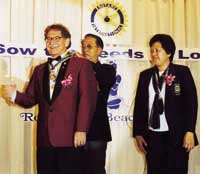 District
Governor Prasert Chaimano, for R.I. District 3340 presents the
president’s medal to Bruno Keller as outgoing president, Alvi
Sinthuvanik look on. District
Governor Prasert Chaimano, for R.I. District 3340 presents the
president’s medal to Bruno Keller as outgoing president, Alvi
Sinthuvanik look on.
For the many Rotarians from all over Thailand, this is
a very moving moment as the reigns of power are handed down from the
outgoing president, to be taken up by the newcomer. This was witnessed by
senior Rotarians including District Governor Prasert Chaimano, and by the
Swiss Ambassador to Thailand, HE Hans-Peter Erismann and his wife Madame
Freda.
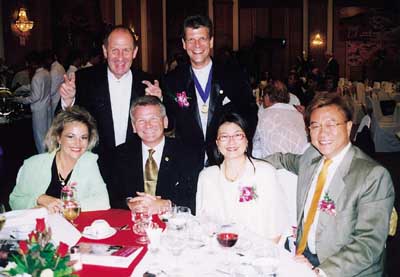
Brian
Sinclair-Thompson (standing left) and Michael Vogt (standing right) have a
bit of fun with Marion Vogt (far left), Andrew Wood, Royal Cliff Beach
Resort’s GM (2nd left) and GM of Hard Rock Hotel Pattaya, Andrew Khoo
and charming wife Rosalind.
For the Jomtien-Pattaya Rotary Club this marked the
finale of (now) Past President Alvi Sinthuvanik. During her Rotary year
(2001-2002) Alvi steered the club through a record breaking 12 months,
within which more funds were raised for charity than at any other time in
the club’s history. Her Walkathon was so successful and so much
appreciated by the community that incoming President Bruno has said that
this will be repeated.
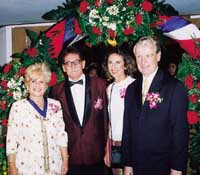 Past
President Erica and new President Bruno Keller stop for a Kodak moment
under the entrance to the ballroom with the Swiss Ambassador to Thailand,
HE Hans-Peter Erismann (far right) and his charming wife Madame Freda. Past
President Erica and new President Bruno Keller stop for a Kodak moment
under the entrance to the ballroom with the Swiss Ambassador to Thailand,
HE Hans-Peter Erismann (far right) and his charming wife Madame Freda.
For himself and his new Board of Directors, President
Bruno has promised a more “businesslike” form of management for his
Rotary Club, coming himself from a very successful business background in
his native Switzerland.
 The
Swiss Ambassador to Thailand, HE Hans-Peter Erismann is given a kiss by
one of the puppets. The
Swiss Ambassador to Thailand, HE Hans-Peter Erismann is given a kiss by
one of the puppets.
Of course, the evening was not all taken up with
congratulations to the outgoing and incoming executives, there was also
time for cultural activities, commencing with the children from the Wat
Pong school performing the Srivichai Dance, and then a rendition of small
sections of the traditional Thai Ramakien, performed by the Joe Louis
Theatre ensemble.
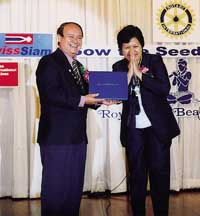 Past
district governor of R.I. District 3340, Premprecha Dibbayawan presents
Alvi Sinthuvanik Rotary’s highest honor, the Paul Harris Fellow award
for her efforts during the past year as president of the Rotary Club of
Jomtien Pattaya. Past
district governor of R.I. District 3340, Premprecha Dibbayawan presents
Alvi Sinthuvanik Rotary’s highest honor, the Paul Harris Fellow award
for her efforts during the past year as president of the Rotary Club of
Jomtien Pattaya.
These puppets and their skilled puppeteers are the
re-birth of the art of the Hun Lakorn Lek (traditional Thai small puppets)
that were created 100 years ago by the famous Master Krea Sapatawanich.
The principal performers, such as the mischievous Hanuman, the monkey god,
then came down into the audience to delight the diners.
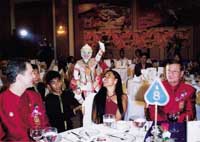 Those
kinky puppets at it again! This time, the mischievous Hanuman visits the
table of the Rotary Club of Taksin Pattaya. Those
kinky puppets at it again! This time, the mischievous Hanuman visits the
table of the Rotary Club of Taksin Pattaya.
After being congratulated by the assembled Rotarians
and friends, President Bruno Keller introduced his new Board, repeating
the theme from Rotary International for the year 2002-2003 - “Sow the
seeds of love” and then concluded the evening’s festivities by again
sounding the ceremonial gong.
 Chanyut
Hengtrakul, advisor to the minister of Science, Technology and the
Environment gets in on the act. This puppet is a real floozy! Chanyut
Hengtrakul, advisor to the minister of Science, Technology and the
Environment gets in on the act. This puppet is a real floozy!
The new Board includes Vice President Jan Olav Aamlid,
Secretary Colin Ritchie, President Elect David Jeater, Immediate Past
President Alvi Sinthuvanik, Treasurer Jon Tellefsen,
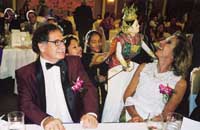 Not
to be outdone, Madame Freda joins in the show. Not
to be outdone, Madame Freda joins in the show.
Club Service Director Erika Keller, Community Service
Director Premprecha Dibbayawan, Vocational Service Director Cav. Peter
Rottmann, International Service Director Martin Brands, Sergeant-at-Arms
Pratheep (Peter) Malhotra.
Germany’s President Rau tours Thai-German Institute in Chonburi
His message to Thailand’s youth: better quality of life through better training
by Elfi Seitz
During his official visit to Thailand, the president of the
Federal Republic of Germany, Dr. Johannes Rau paid a call at the Thai German
Institute in Chonburi. Speaking at the institute, the German leader shared some
wisdom directed at Thailand’s young people. He spoke of a bright future for
the youths of the nation and he stressed that young Thais without much formal
education can raise their living standards by getting better training. The
message carried the same theme as the speech he made on June 12 at the
Chulalongkorn University in Bangkok, where he received an Honorary Doctorate of
Political Science.
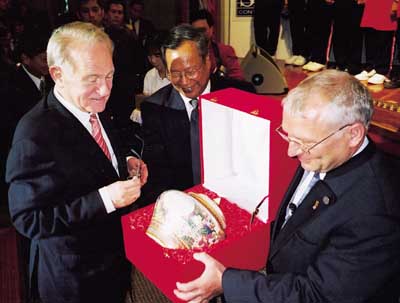
The
directors of TGI, Walter Kretschmar (right) and Narong Rattana (center), present
the German federal President Johannes Rau (left) a big vase of Benjarong
ceramics as remembrance to his visit at TGI.
Dr Johannes said, “Education and training are keys to
success in the future. Thailand’s former King Chulalongkorn realized this
during his reign. One hundred years ago he arranged a system for all levels of
society to have access to formal schooling.”
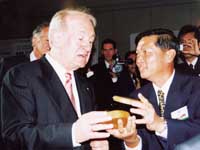 Chadej
Insawang, Chonburi provincial governor (right) presents the German President a
teak carving as remembrance to his visit at the Thai Eastern Seaboard. Chadej
Insawang, Chonburi provincial governor (right) presents the German President a
teak carving as remembrance to his visit at the Thai Eastern Seaboard.
The German President quoted the former ruler: King
Chulalongkorn said, “My children, and all other children from every social
level shall have the chance for an education. We must all learn that education
is the most important part in life.”
During a gala banquet hosted by Prime Minister Thaksin, Dr.
Rau said, “A very important date will be my visit to the Thai German Institute
in Chonburi. This organization is a highly successful and united project aimed
at furthering young people’s education. Since 1959, Germany and Thailand have
worked together in this field. We are now working toward new guiding principles,
and to cement further cooperation.”
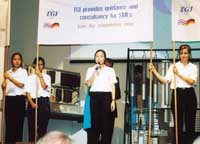 The
young people of TGI present the messages of the institute on banners and in
short speeches in Thai, German and English. The
young people of TGI present the messages of the institute on banners and in
short speeches in Thai, German and English.
Dr. Rau received a warm welcome on his arrival in Bangkok.
His stay was greatly honored by an audience with Her Majesty, Queen Sirikit. But
with all of these important meetings, he still made time to visit TGI and the
Eastern Seaboard.
“It was a great honor that the president came to visit our
institute,” said Walter Kretschmar, the German director of TGI. VIPs from the
world of finance, business and politics were invited to welcome the president.
The German president’s visit at the TGI also reflected his private interests,
as he was once Minister of Science and Research in North-Rhine, Westphalia.
 The
tuk tuk president. The German President Johannes Rau inside an environmentally
friendly, electrically operated tuk tuk of the Thai company Polasith-Tuktuk. The
tuk tuk president. The German President Johannes Rau inside an environmentally
friendly, electrically operated tuk tuk of the Thai company Polasith-Tuktuk.
Young people presented the entertainment part at his visit to
the TGI. “We decided not to make a lot of speeches, but we wanted to pass on
messages of TGI. We chose young people from both Germany and Thailand to parade
with banners,” said Walter Kretschmar. The idea mirrored the motto of TGI: Not
German, not Thai = TGI.
Young people outlined their hopes for the future. They feel
that TGI should be a place where things are done differently; an institute
creating space for innovative ideas. They want well-trained professionals to
take responsibility for the future of Thailand’s environment, health and
safety. They feel TGI can provide a meeting point for engineers to share their
ideas, and could become a gateway to communication in technology and business.
A special, a composition of His Majesty the King was played,
“Sounds of Works” based on the machines and technology also used at TGI,
symbolizing TGI’s commitment to success through innovation and creativity.

The German
president gets informed about the training at TGI by TGI director Walter
Kretschmar (center). Andreas von Stechow, the German ambassador in Thailand
(right) watches carefully.
Dr. Rolf Slzer, director of GTZ opened the event by
pointing out the importance of TGI for the technical improvement of Thailand.
“In March 1959, 43 years ago, an agreement was signed between Germany and
Thailand to establish a Technical Training Center, at the King Mongkut Institute
in Bangkok. Thousands of students and young teachers went to Germany and retuned
with understanding and practical experience that cannot be absorbed from books.
Two generations later these people still carry new concepts development and fuel
demand for higher skills,” Dr Rolf said.
As a result of this bilateral cooperation, training and
education programs supported by Germany are in every province of Thailand. Dr
Rolf added, “TGI is but one example of this growing involvement of the
industry in shaping the training programs of tomorrow.”
Naron Rattana and Walter Kretschmar, the two directors of the
TGI spoke at the meeting. Narong said, “When the president of Germany planned
his visit to Thailand, he chose our institute as the one place to visit outside
Bangkok. His presence here punctuates the strength of co-operation that set up
this institute.”
Alter Kretschmar added, “The TGI is a fine example of
beneficial international cooperation, and the German president has recognized
this. His visit will stand as a milestone in the history and development of TGI.”
The German government recently agreed to support TGI as a
technology transfer institute for three more years by sending German experts to
work with the institute’s staff and sending TGI’s staff for training to
Germany.
The German president made a tour of the TGI premises,
starting with the Exhibition Hall. Dr Rolf showed the visiting president all the
laboratories and workshops. Currently, 35 companies and service providers are
showcasing their products and range of services in the hall.
Finally, a traditional Thai lunch was served to the sounds of
Thai music and an elegant display of fruits carving and Thai desserts was
presented.
AustCham turns 25 years young
Celebrates with the 2001 Aust-Thai Business Awards
Story and photos by Peter Cummins
It was an all-star cast, with super emcee David Wright in
rare form, as he moved the evening along very professionally, with top-class
speakers and, of course, announcing the Business Awards Winners for 2001 who
received their prizes from Pichai Chuensuksawasdi, editor-in-chief of Bangkok
Post.

Rewards for
the winners and AustCham supporters.
The winners were:
1. Business of the Year Award: John Kershaw’s Linfox
Logistics (Thailand) Limited
2. Best Small-to-Medium Enterprise Award: Bob Coombes’
Choice Foods Thailand Limited
3. Special Awards (random listing):
Clough-UNITHAI Engineering Limited
Australian Education International (Tony Michener, counsellor,
education and training, has just departed for a new assignment in Jakarta. We
shall miss him)
NDC Global Services
Baker and McKenzie (our own John Hancock took the honours)
Laem Chabang International Terminal Company Limited (Our own
Eastern Seaboarder, Langford shows that he cannot only helm a yacht off the
Jomtien-Pattaya coast, but he also runs a ‘tight ship’ at the Laem Chabang
Terminal)
A number of plaques and awards were also distributed to
various AustCham members for services rendered over the years.
The press - then and now
It was, indeed a splendid - and nostalgic - evening when
Pichai Chuensuksawasdi, the newly-appointed editor-in-chief of the Bangkok Post
(promoted from just plain ‘editor’ several weeks ago), made a marvellous
keynote speech and presented the awards to the most successful Australian
companies throughout 2001.
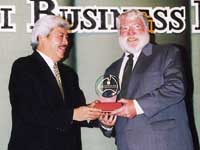 Pichai
presents Bob Coombes his Award for Excellence. Pichai
presents Bob Coombes his Award for Excellence.
Introduced by Jane Furber, company representative of
Qantas/British Airways, one of the co-sponsors of the awards, Pichai immediately
launched into his memorable monologue. Sporting a superb head of thick white
hair, he pointed out that when he was undertaking his Bachelor of Arts in
Political Science at the James Cook University and, later, a B.A. in Journalism
at the University of Queensland, he was slim, fit, with jet-black hair and well
tanned from enjoying the Aussie way-of-life: on the beaches, at the barbecues,
drinking the odd beer or three... “Oh, yes, I slipped in some study, too,
between these activities,” he intimated. “Now, look at me - and you can see
the ravages of a career in the media: totally white hair, physique gone...”
 Farewell
Education and Training Counsellor Tony Michener. Farewell
Education and Training Counsellor Tony Michener.
Held at the beautifully-decorated ballroom of the Grand Hyatt
Erawan Hotel, Pichai gave the 200-some attendees a rare insight into the
workings, machinations and struggles of the press in Thailand - both Thai and
foreign - to rise above endless coups, counter-coups and the meddling of
successive governments. Indeed, the past quarter of a century has seen a
newsroom develop from a “cutting and pasting” graveyard, to a highly
sophisticated information technology vehicle, distributing instant news from
around the world. (My own frequent visits to the Bangkok Post always amaze me,
when I see a huge area with an almost endless sea of people totally intent upon
the computer screen, churning out text and pictures. So much so, that I have now
given away my portable Olivetti typewriter and have moved - albeit, gingerly -
into the doorway of IT.)
“All-in-all,” Pichai summed up, “we now have greater
freedom (of the press) which, in turn, spells better journalism.” I consider
that now the press is “more lively, vibrant and provocative, contributing to a
more-open society,” Pichai added. “There are still problems, as we saw
earlier this year, but PM Thaksin now has a great opportunity to open the way
for greater freedom.”
 Bangkok
Post’s Pichai Chuensuksawasdi addresses the gathering. Bangkok
Post’s Pichai Chuensuksawasdi addresses the gathering.
Press freedom, in fact, is guaranteed by Article 39 of the
Constitution (the 18th, no less) which states, inter al.: “Freedom of thought
and expression is guaranteed and official censorship of newspapers, radio and
television is prohibited...” Pichai did not spell that out, but every day in
our Bangkok Post it appears in the upper corner of the first page!
AustCham President Marc Driscoll added a rather appropriate
footnote when he addressed the gathering: “News is the preview of history:”
which was a cue for John Hancock to launch into the history of the Chamber.
In the beginning...
The night down memory lane was most aptly described by John
Hancock, a stalwart of the formation of the Chamber which started in 1977 as a
business men’s luncheon club, “The whole four of us,” laughed John,
“meeting once a week for lunch and a beer or two.” The very thought of a
foreign Chamber of Commerce was anathema to a xenophobic and suspicious
government, composed of military men, many of whom were ‘wannabe’ despots.

Eastern
Seaboard’s finest: Chris Langford and his Laem Chabang team.
John’s memory was infallible, recalling hundreds of
anecdotes of the past 25 years, outlining the great strides made by the Chamber
and the dedication of its founding, long-standing and newer members who have
been instrumental in contributing so much to Thai society, especially the
disadvantaged and dispossessed.
Among his many thoughts, John remembered that the evening’s
venue was once a three-storey structure, that a telephone call in those days was
accompanied by incessant Chinese music where the caller would not ask WHO you
were, but WHERE you were. The telex (can anybody remember that monstrosity? I
heard one minister of religion tell his parish once that there were originally
100 Commandments handed down through Moses, but the tablets of stone were far
too heavy for poor old Moses. So, God sent them by telex. By the time the
transmission arrived, the 100 were down to Ten!)
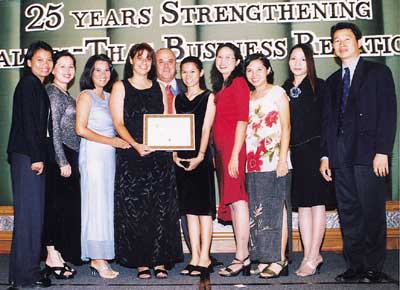
Steele
Lambrinos and staff of Kirwin Industrial Services Co. Ltd.
Too many to mention here, John commended such former chamber
presidents as Brian Hurrell and Gary White, the latter, five-time president and
perennial supporter of all AustCham projects, through the WESTPAC Banking
Corporation, including sponsorship of the evening, along with Qantas and others.
With splendid orchestral music during the “Happy Hour”
reception and punctuated during the evening, excellent food and wine which is a
now-envious feature of all AustCham receptions at the Embassy Sundowners and
elsewhere, and, of course, the usual cordial mix of Thais and Aussies, the 2001
Awards and Twenty-fifth anniversary of the Australian-Thai Chamber of Commerce
was a “night to remember”! I hope I am around for the 50th, when I shall be
a mere ‘boy’ of just 92 - and, hopefully, still writing and taking pictures!
First lady of Wine
by Ranjith Chandrasiri
One of the most distinguished personalities in the male
dominated world of wine is a remarkable woman - Baroness Philippine de
Rothschild, the chairperson of Baron Philippe de Rothschild SA - one of
the leading family owned wine dynasties in the world. She is a powerful
businesswoman, a high profile ambassador for Bordeaux - the Mecca of wine
and the most respected member of the Primum Familiae Vini (First families
of Wine).
Unlike other female Rothschilds of her generation she
is an accomplished actress as well as a successful businesswoman. She
insists, “People think Rothschild women spend their day lounging around
reading magazines. My lifestyle is different, I work every day and I am a
busy businesswoman.”
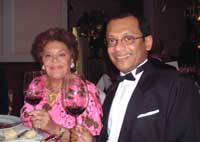 Ranjith
Chandrasiri appreciating a great vintage of inimitable Chateau Mouton
Rothschild with the Baroness Philippine de Rothschild. Ranjith
Chandrasiri appreciating a great vintage of inimitable Chateau Mouton
Rothschild with the Baroness Philippine de Rothschild.
Philippine was a child in occupied France during the
Second World War. Her father joined the Free French in London under
General de Gaulle. Her mother, the first Baroness Philippe, was captured
by the Gestapo in 1944 and deported to Ravensbrck where she died
in 1945.
Growing up with a passion for the theatre, Philippine
studied acting in Paris and graduated from Conservatoire National d’Art
Dramatique in 1958. She was a member of France’s prestigious national
theater La Com้die Fran็aise for a decade, working with stars
such as Catherine Deneuve. In 1973, Philippine starred in one of the
leading roles in a French adaptation of Hal Ashby’s film Harold and Maud
and toured with the production for several years. “I was an employee and
got paychecks. Not many Rothschilds have received paychecks,” she says.
During the 1980s she gradually withdrew from her stage career to take an
active part in the family business.
Ancestry of Mouton Rothschild wine dynasty dates back
to 1853, when Baron Nathaniel, one of the sons of Baron Nathan bought Chโteau
Brane Mouton, an estate in Pauillac in the heart of M้doc and gave
it his own name - Chโteau Mouton Rothschild.
When Baron Nathaniel died in 1870, his son Baron James
and grandson Baron Henri in turn inherited the property but neither showed
much interest in the art of wine making. In 1922, at the age of 20
Philippe de Rothschild, the youngest son of Baron Henri took the destiny
of Mouton in hand and in just two years revolutionized the method of
bottling and labeling the wines that many other great Bordeaux chโteaux
would follow.
Until then, for a century or more, Bordeaux chโteaux
had shipped their new wine in barrels to merchants’ warehouses in the
city. The merchants then aged the wine, bottled and sold it around the
world often featuring the merchant’s name prominently as the chโteau’s.
Philippe didn’t favour this system, he wanted to assure the customer
that each bottle was an authentic product of his chโteau and decided
that he would take the responsibility for the entire process and bottle
his wine at the chโteau. In his 1981 autobiography, “Vivre la
Vigne,” he wrote “My wine must leave my chโteau in my bottles
with my labels.”
To accomplish his vision he had to overcome several
challenges. First of all, he needed a new barrel-aging facility big enough
to hold two entire harvests since the wine needed to be aged in barrels
for two years. So Rothschild built the Grand Chai, 100 meters long
cathedral-like space that subsequently served as a model for many other
chateaux.
Next was the label. At that time, most labels were
small, insipid and often with just text only. Philippe wanted to make an
unmistakable statement about his labels and hired Jean Carlu, a
fashionable commercial artist to design a new label. The Carlu label was
revolutionary, in bold red, black and gold; it featured a fierce ram’s
head, the symbol of Mouton, and five arrows, the Rothschild family emblem.
To emphasize that the wine was bottled at the estate, the now familiar
words “Mis en bouteille au chโteau” was also added to the label.
The criticism of the Carlu label was severe; it was too
much of a blow to the tradition. So after three vintages, he went back to
a simple design of text and gold. But labels would never be the same in
Bordeaux, in the 1930s and ’40s many chโteaux experimented with
their labels, trying photography and new typefaces.
In 1945, returning from an exile that had taken him as
a prisoner, refugee and a soldier through Spain, Morocco and England,
Philippe turned again to the label to make his statement, choosing
Philippe Jullian to create it - to let the world know that Mouton had
survived the war. Mouton adorned its 1945 label with the now-famous
“Victory” insignia, and since then every vintage’s label has borne a
distinctive work of original art by a contemporary artist - Picasso,
Warhol, Cocteau, Chagall, Dali, Mir๓ and Balthus among them. Perhaps
the most famous of all, Pablo Picasso created the label in 1973, the year
Philippe finally succeeded in his lifelong quest to have Mouton elevated
to first-growth status.
As the label series took on greater importance,
Rothschild became choosy about the stature of the painters and the quest
for labels became a full-time job. So Philippine mostly took it over.
Realizing that both art and wine are now global businesses, she reached
out to new frontiers seeking more international artists and sculptors.
In 1981, Philippine decided to exhibit the labels and
the artwork. Working with Xavier de Eizaguirre, the current managing
director of Mouton, she assembled all the labels and gathered the original
artist’s idea along with the sentimentality of the personal attachment
that linked each artist with Mouton. “Mouton Rothschild Paintings for
the Labels” has been recognized as a serious collection of art on its
own and exhibited in museums around the world. After opening in 1981 at
the Contemporary Art Museum of Montreal, the exhibition moved to Japan,
Scotland, England and all across the United States before closing in
Berlin in 1992.
The series of artist wine labels is just the tip of the
iceberg when it comes to Mouton-Rothschild and fine art. Baroness
Philippine herself is an accomplished artist in her own right and the late
Baron Philippe was a keen collector of works of art related to wine. His
collection, which is displayed in the wine museum on the chโteau
ground, ranges from ancient Persia to Ming Dynasty China to Renaissance
Europe, from pottery to painting to precious stones, from tiny enamels to
enormous tapestries. All are somehow related to wine.
Among the most impressive objects on display are a
16th-century German nautilus-form drinking cup, a gilt-mounted seashell, a
15th-century French tapestry showing the grape harvest, and a squat
pottery fellow in a snap-brim hat chugging a cup of wine. It is always a
delight to visit chโteau Mouton and every time I go to Bordeaux I
don’t miss the opportunity to visit the art museum, the Grand Chai,
where the barrels of new wine are kept and the dusty, mysterious cellar
that holds the chโteau’s library of old bottles.
Baroness Philippine inherited the Mouton Rothschild
wine dynasty including three estates in Bordeaux - first-growth Chโteau
Mouton Rothschild and two fifth-growths, Chโteau d’Armailhac and
Clerc Milon- as well as Mouton-Cadet, Bordeaux’s largest-selling n้gociant
brand when her father died in 1988. She has the distinction of being
Chevalier de la L้gion d’Honneur and Commandeur des Arts et
Lettres.
Succeeding the legendary Baron wasn’t an easy task
but Philippine, with her natural flair and sharp acumen has steered the
family company, doubling the sales since she took over. She is not
thinking of retirement yet but when she does retire, she expects her two
sons to take over the business. Philippe is a businessman and Julien is an
artist. She expects that they will compliment each other. “They have
different fields of activities. Philippe is into finance, Julien could be
into the labels, the (Mouton) museum, and why not, the winemaking.”
During a recent meeting with the Baroness, I learnt
that she is especially fond of South East Asia and has visited Thailand
several times but never been to Pattaya. Naturally I extended her an
invitation to visit our wine club and hope we will have the opportunity to
host the first lady of wine as an honoured guest of the Royal Cliff wine
club in the near future.
Ranjith Chandrasiri is the resident manager, Royal
Cliff Grand, Royal Cliff Beach Resort, 353 Pratamnak Road, Pattaya,
Chonburi 20150, Thailand, email: [email protected] or [email protected]
The Chaine brings on the brunch
by Miss Terry Diner
Marion Vogt, the Bailli of the world famous gastronomic
group, the Chaine des Rotisseurs local branch was the stunning hostess for
another very successful fine dining event in Pattaya. This was the Chaine
des Rotisseurs Sunday Brunch held at the Casa Pascal restaurant on Second
Road.
While popular opinion would put such a gastronomic
group as the Chaine des Rotisseurs into the category of a group holding
stuffy, formal, seventeen course dinners, this is definitely not the way
of the progressive local chapter.
 Pascal
Schnyder, the executive chef and owner of Casa Pascal was more than ready
to meet the challenge of producing brunch for the august group, which
includes almost every executive chef in Pattaya. Having run Sunday
brunches for some months now, Pascal expanded the menu, adding such
imported items as Tasmanian oysters, US prime rib, white asparagus and
Alaskan king crab for the Chaine members and guests. Pascal
Schnyder, the executive chef and owner of Casa Pascal was more than ready
to meet the challenge of producing brunch for the august group, which
includes almost every executive chef in Pattaya. Having run Sunday
brunches for some months now, Pascal expanded the menu, adding such
imported items as Tasmanian oysters, US prime rib, white asparagus and
Alaskan king crab for the Chaine members and guests.
The food on offer was comprehensive and varied. Hot
dishes, soups, salads, cheeses, pasta, eggs, seafood and cold cuts, and
even cornflakes. The crab legs deserve a mention of their own. Universally
acclaimed, these Alaskan king crabs must have been 2 metres tall when
alive! The legs were so enormous! The roast was another tour de force,
with all the carnivores present simply raving about the flavour and
texture. It was noted, however, that nobody tried the cornflakes!
To be judged by one’s peers and restaurateurs of the
calibre of Bruno Forrer (Bruno’s), Louis Noll (Mata Hari) and Hans
Banziger (Paradise Cafe & Grill) plus all the local gourmets, could be
a daunting experience, but there was no doubt that the Casa Pascal Sunday
Brunch met the approval of all the diners. The presentation of the
certificates was accompanied with genuine applause for a fine culinary
experience.
Congratulations Marion Vogt, Pascal Schnyder and the
Chaine des Rotisseurs. For further information on the Chaine you may
contact Marion Vogt by email on [email protected]
The Sheraton Grande Thank-You Party: A Swinging Success
It was, indeed, a splendid night at the Sheraton Grande
Sukhumvit recently when the hotel decided to say “thank you” to the
press and media - particularly the Pattaya Mail which has long
supported Sheraton programmes - and the clientele, representing a vast
cross-section of Bangkok society, who have supported the hotel’s social
events over the past few years.
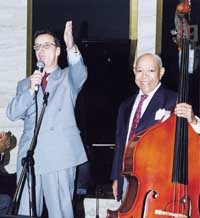 “Let’s
here it for Eldee Young,” shouts Sheraton GM, Richard Chapman. “Let’s
here it for Eldee Young,” shouts Sheraton GM, Richard Chapman.
The evening coincided with the third anniversary of the
jazz greats - led by the personable jazz master himself, Eldee Young who,
along with Shawn Kelley, Taurey Butler, Randy Cannon et al. over the past
few years have converted the Sheraton’s “Living Room” into the
“Jiving Boom” which is engulfing Bangkok, especially the now-famous
Sheraton Sunday Jazzy Brunch. The Brunch was just one of the several
awards of excellence which Metro Magazine accorded the hotel at last
year’s ratings for the best wining, dining and entertainment venues in
the metropolis.
The timing of the Sheraton party was great also, for it
coincided with Pattaya’s own new jazz venture, the re-launch of the Jazz
Pit, the pride and joy of Dr Sanya Viravaidya, director of the Pattaya
International Clinic, the opening of which was a highlight of the Pattaya
jazz scene and is likely to be the jazz-lovers’ “in-place” for the
future.
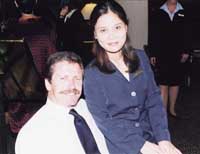 Colin
takes a moment off to ‘fraternize’ with one of the Sheraton’s
beautiful PR girls: no doubt we shall see her in “Big Chilli”, too! Colin
takes a moment off to ‘fraternize’ with one of the Sheraton’s
beautiful PR girls: no doubt we shall see her in “Big Chilli”, too!
The Sheraton show was a great mix of newshounds,
musicians, Sheraton Grande devotees and a bevy of the beauties who attend
Sheraton functions and the equally-beautiful staff who serve. All
thoroughly enjoyed the festivities - especially the Pattaya Mail
special correspondent who, as usual, was one of the first to arrive and
one of the last to leave. But, of course (also as usual) he reported
diligently on the evening’s events.
 Publisher
Colin Hastings (who produces a whole range of up-market magazines now
hitting the newsstands, including the very popular “Big Chilli”) and
Jennifer Su (That Hat Lady), famous television and radio presenter. In the
middle of this ‘Wall of Fame’ is Sheraton Grande Sukhumvit general
manager, Richard Chapman who compered the marvellous evening. Publisher
Colin Hastings (who produces a whole range of up-market magazines now
hitting the newsstands, including the very popular “Big Chilli”) and
Jennifer Su (That Hat Lady), famous television and radio presenter. In the
middle of this ‘Wall of Fame’ is Sheraton Grande Sukhumvit general
manager, Richard Chapman who compered the marvellous evening.
Among the notable reporters and writers acknowledging
the Sheraton’s munificence were Bernie Cooper, perhaps the dean of the
press corps who is everywhere - all the time - especially where his three
main specialties, food, drink and jazz (not necessarily in that order of
preference) are featured. Another high-profile presence was jazz devotee,
a musician in his own right and a rather handy fellow with his camera,
Alex Pithie, who was busy recording everyone who moved - and some who did
not.
|